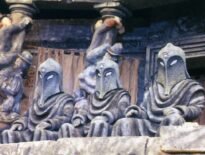Hello, hello, welcome! So nice to see you back for another tour of the Under Gallery; all 87 of you at a glance. And three of you are Zygons. But I’m not telling anyone which three. And someone from the 23rd century, by the look of those implants. Mind your antennae on the low doors, sir, we don’t want any accidents.
You are probably wondering why the Curator isn’t guiding you round the Under Gallery today; well, he does tend to disappear mysteriously, quite a lot. In fact, I sometimes wonder if he exists in another plane altogether and only appears to be here. He told me once that he thought London was a dump, and though he spends time here, he doesn’t have to like it. Don’t be offended — I’m sure he likes all of you, it’s just that he gets called away. He said it was to judge a synchronised swimming competition on Betelgeuse 4, but as there’s no liquid water on Betelgeuse 4, I think he’s probably negotiating peace between Sontarans and Rutans. Again.
So, he’s asked me to take you round today. I’m a bit nervous, but I was once told I should have more confidence. Even bad people can be right sometimes. So — on with the tour: this week, the Hall of Walls!
Art doesn’t have to have enormous gilt frames or marble plinths. There’s such a lot of art preserved directly on walls. There’s straight forward graffiti; then history, carvings, warnings, murals, and the occasional giant snake.

Then there’s all sorts of things temporarily stuck on walls – posters, propaganda, prohibitions.
“Why do people write things on walls?”
Well, they last a long time, and as the Doctor said, ‘you can’t lose a wall.’
(Actually he stole that line from Isobel Watkins [The Invasion]). Also, if you really want someone to notice something, write it on a wall. Big.

This is the largest exhibit. A person who always knows how to get attention: sometimes, she’s more subtle than this, though not often. Yes, you can pose in front of it – would you like me to take a picture? Selfies are never as good are they?

River and the Doctor both have a habit of writing on walls. He got attention when he wrote this declaration on a wall, using an unusual tool to do so. But he said it was better than using it for what it was made for. The Doctor would use a wall to work things out – in fact, she claimed to be Banksy, but was fibbing: I know who Banksy really is. But I’m not telling.

Sometimes a wall is just a good way of preserving a message for a long time.


Graffiti is more than ‘vandalism’ or mere scribbles – it can be astonishingly artistic, and it is definitely identity for so many.



But if you want a real graffiti artist, there’s none to beat Rigsy; his painting was so good, it saved the world. After he encountered some of the most disturbing wall art we’ve come across – skin, nerves, humans flattened to 2D.




Not everyone’s as gifted, but this artist was pretty traumatised at the time.

That was a subconscious race memory, but wall art is often a very conscious, deliberate attempt to write history. Or rewrite it, depending on which version of Atlantis you’re in.




These wall tiles are one of his earliest histories of the Thals. And their enemies the Daleks weren’t averse to a bit of wall art too, even if they claim it’s functional.


Histories writ large on walls are often made by societies with really big egos – like the Pharaohs. I wonder if the Doctor would like a hat like that?





Funny how supposedly powerful beings like to spin their history as warning, or even threat.
‘Was Sutekh responsible for the construction of the Sphinx?’
We suspect he had a hand in it, yes.


This one is also a puzzle, to a secret door and passageway. Would you go in if it opened? Are you the sort of person who’d venture into a dark tunnel with no idea what lay beyond? There might be a job for you in UNIT. See me after the tour.

Above: The Doctor and Bellal come across an ad for an ancient TV channel

Artistic puzzles are not unusual, and usually obvious once you see them – like those magic eye 3D pictures – I love those, don’t you? Most species like the pleasure of solving a puzzle. Apart from the Judoon; they prefer poker.
The Doctor could, of course, pop back and watch the people create their wall art, but I think he just likes the mystery, or solving the puzzle. Have you noticed how really clever people sometimes need the screamingly obvious pointing out…?



Not everything that looks old and historical is to be taken at face value. UNIT tries to defend the planet, which is lauded when it’s aliens we’re resisting. Oddly, we are less popular when it’s the earthly authorities’ abuse of power we have to resist. We’ve been officially closed down more than once, but we can operate underground when necessary.

Sometimes, wall art is so old that the meaning is lost, though the art remains. Often when it is meant to be a warning, the cultures that look at it now are so many years and light years away from the people who designed it that we don’t get the message. Other times the human instinct for self-preservation picks up the race memory pretty clearly.



Enough with the portentous portals! Everyday wall art is worth a look just as much as ancient history. They tell us who we are, where we are, what we’re doing there. And what to expect…
Here’s an interesting take on the old ‘comedy/tragedy’ face mask used to denote theatre. Just a skull – the Happiness Patrol left nothing to laugh at. Another regime successfully resisted by dropouts, rebels, and the blues.

Big wall art is often used to set a tone, like these in corporate hospitality, hotels, cruises.




Above: Let’s welcome Turlough to the podium…
The tone set by the wall art is not always aimed at beauty, but at making a statement about who has the power. Or who would like to think they have.



Powerful people’s wall deco choices can be controversial, but sometimes there’s a legitimate reason for the material used.

Other statement wall art is more fun, expressing the personalities of the people who create them.

And when people are eating, they seem to love to have art on the walls around them.

My auntie had a row of ducks on her dining room wall. What would UNIT have said if they knew my Uncle Tom had rigged the middle one up with some – er – borrowed tech so that she could contact him wherever he was?

Talking of Uncle Tom, here’s a bit of art he only got to see after the crisis was over, when UNIT got into the village and especially the pub.

Pub signs are often overlooked, or more accurately underlooked, being over people’s heads – but can tell you a lot, or give you cause to ask what stories lurk in the locality.




So, from pub signs to more temporary wall art like posters, advertising and propaganda. Images speak louder than words and stick in our heads — like this crocodile illustrating the importance of pit props in LLanfairfach.

Posters may be ephemeral, but can tell you a great deal about whatever situation you find yourself in; vital when the TARDIS ends up somewhere dangerous. So all the time then.




If an artist is really lucky, they may be able to earn their living through ‘pure’ art, but we shouldn’t dismiss art done for marketing or powerful interests. We all need goods and entertainment, though some are not necessarily good for you!






I wonder if that young man knew, before he died, that bow ties were cool, and geeks have always been chic? But I’m getting carried away. Sorry.
Advertisers can get a bit carried away, to the annoyance of property owners. Though he said it wasn’t as bad as painting the TARDIS pink.



You could just enjoy the art design or calligraphy, but working with the Doctor trains you to look more carefully; there are sometimes clues and connections – even warnings – the casual observer might miss. And spotting the clues can save your life.




When your life becomes the subject of a poster, you really have to worry.




Dan certainly was much happier being the subject of a poster; advertising an ethos, something the company was proud of.

But advertising which identifies particular persons can descend into demonising opponents.

So beware of propaganda masquerading as news or adverts, and be especially cautious with anything posted on the side of a bus!

Ephemeral wall art is often advertising who we are, for good or ill. At least Jo could see what she was letting herself in for!


And Ace could see what she’d left behind.

As the Doctor said, “some people have the strangest ideas about décor.”

Plague warnings are useful but there are more subtle dangers shown in posters; who could this kindly looking gentleman be?

(Actually, it’s Jack Kine, head of the Visual Effects Department at the BBC, whose predecessor Roy Oxley had been the model for Big Brother in Cartier’s BBC adaptation of Nineteen Eighty-Four.)
If a leader has to put up a BIG poster of themselves, you have to question what they are up to.




Propaganda takes all forms, and no species is immune.

One has to have respect for that design; it implies movement, catastrophe, an unstoppable force. Thankfully, we stopped that catastrophe, together. Was I scared? Yes, of course, but I’m UNIT trained; I’ve been bombed, shot at, knocked unconscious, interrogated, and trapped in an alternative universe where everyone was evil, including me. But worst of all, my parents named me ‘Petronella’ and sent me to a comprehensive in east Croydon. Why do people have so much difficulty living with someone who is different?
Clashes between different people on the same planet seem insane to anyone who’s travelled the universe, and it can be harder to deal with your own history than splinter groups of aliens among us.

So I have saved this one til last; when my OCD is bad, stressed at the chaos out there, I come in here and look at this bit of wall.

‘It is forbidden to dump bodies into the river.’ Not ‘in’, but ‘into’. ‘In’ would imply you were standing in the water dumping bodies while you got wet; this means standing outside the river dumping bodies into it from the bank, or the bridge.
But look at what is tells us in such perfect English: there are so many bodies – dead people – that the normal funerals, graves, human mourning rituals, have been abandoned. So plague, or war, or both. And that word ‘Forbidden.’ No fine or fixed penalty is mentioned, not because there was no penalty, but because there was no limit to what might happen to you if you were caught. Totalitarian dystopia in 9 grammatically perfect words. Sigh. Makes whatever we have to deal with when we go back outside just that little bit better.
But, if you still need a little help facing the world, the cafe on the way out sells gorgeous ice cream now – I helped them out once with a minor Wirrn infestation in the disabled toilet, so they owed me a favour – or a flavour as the Curator might say. Oh dear; his sense of humour is catching. Time to call it a day, and I’ve a couple of boxes to keep an eye on.
But do come again. Meanwhile, keep your eyes on the walls – you never know when you might need to have noticed them.



